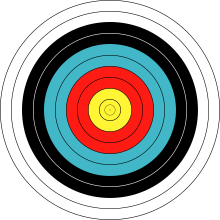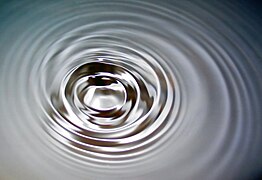Concentric objects


Ingeometry,two or moreobjectsare said to beconcentricwhen they share the samecenter.Any pair of (possibly unalike) objects with well-defined centers can be concentric, includingcircles,spheres,regular polygons,regular polyhedra,parallelograms, cones, conic sections, and quadrics.[1]
Geometric objects arecoaxialif they share the sameaxis(line of symmetry). Geometric objects with a well-defined axis include circles (any line through the center), spheres,cylinders,[2]conic sections, and surfaces of revolution.
Concentric objects are often part of the broad category ofwhorledpatterns,which also includesspirals(a curve which emanates from a point, moving farther away as it revolves around the point).
Geometric properties[edit]
In theEuclidean plane,two circles that are concentric necessarily have different radii from each other.[3] However, circles in three-dimensional space may be concentric, and have the same radius as each other, but nevertheless be different circles. For example, two differentmeridiansof a terrestrialglobeare concentric with each other and with theglobeof the earth (approximated as a sphere). More generally, every twogreat circleson a sphere are concentric with each other and with the sphere.[4]
ByEuler's theorem in geometryon the distance between thecircumcenterandincenterof a triangle, two concentric circles (with that distance being zero) are thecircumcircleandincircleof a triangleif and only ifthe radius of one is twice the radius of the other, in which case the triangle isequilateral.[5]: p. 198
The circumcircle and the incircle of aregularn-gon,and the regularn-gon itself, are concentric. For the circumradius-to-inradius ratio for variousn,seeBicentric polygon#Regular polygons.The same can be said of aregular polyhedron'sinsphere,midsphereandcircumsphere.
The region of the plane between two concentric circles is anannulus,and analogously the region of space between two concentric spheres is aspherical shell.[6]
For a given pointcin the plane, the set of all circles havingcas their center forms apencil of circles.Each two circles in the pencil are concentric, and have different radii. Every point in the plane, except for the shared center, belongs to exactly one of the circles in the pencil. Every two disjoint circles, and every hyperbolic pencil of circles, may be transformed into a set of concentric circles by aMöbius transformation.[7][8]
Applications and examples[edit]
Theripplesformed by dropping a small object into still water naturally form an expanding system of concentric circles.[9]Evenly spaced circles on the targets used intarget archery[10]or similar sports provide another familiar example of concentric circles.
Coaxial cableis a type of electrical cable in which the combined neutral and earth core completely surrounds the live core(s) in system of concentric cylindrical shells.[11]
Johannes Kepler'sMysterium Cosmographicumenvisioned a cosmological system formed by concentric regular polyhedra and spheres.[12]
Concentric circles have been used on firearms surfaces as means of holding lubrication or reducing friction on components, similar tojewelling.[13]
Concentric circles are also found indiopter sights,a type of mechanic sights commonly found on target rifles. They usually feature a large disk with a small-diameter hole near the shooter's eye, and a front globe sight (a circle contained inside another circle, calledtunnel). When these sights are correctly aligned, the point of impact will be in the middle of the front sight circle.
-
Ripplesin water
-
Histologyof aPacinian corpuscle,in a typical expanding circular pattern.
-
Tree rings, as can be used fortree-ring dating
See also[edit]
References[edit]
- ^
Circles:Alexander, Daniel C.; Koeberlein, Geralyn M. (2009),Elementary Geometry for College Students,Cengage Learning, p. 279,ISBN9781111788599
Spheres:Apostol (2013)
Regular polygons:Hardy, Godfrey Harold(1908),A Course of Pure Mathematics,The University Press, p. 107
Regular polyhedra:Gillard, Robert D. (1987),Comprehensive Coordination Chemistry: Theory & background,Pergamon Press, pp.137, 139,ISBN9780080262321.
- ^Spurk, Joseph; Aksel, Nuri (2008),Fluid Mechanics,Springer, p. 174,ISBN9783540735366.
- ^Cole, George M.; Harbin, Andrew L. (2009),Surveyor Reference Manual,ppi2pass, §2, p. 6,ISBN9781591261742.
- ^Morse, Jedidiah (1812),The American universal geography;: or, A view of the present state of all the kingdoms, states, and colonies in the known world, Volume 1(6th ed.), Thomas & Andrews, p. 19.
- ^Dragutin Svrtan and Darko Veljan (2012),"Non-Euclidean versions of some classical triangle inequalities",forumgeom.fau.edu,Forum Geometricorum, pp. 197–209
- ^Apostol, Tom(2013),New Horizons in Geometry,Dolciani Mathematical Expositions, vol. 47, Mathematical Association of America, p. 140,ISBN9780883853542.
- ^Hahn, Liang-shin (1994),Complex Numbers and Geometry,MAA Spectrum, Cambridge University Press, p. 142,ISBN9780883855102.
- ^Brannan, David A.; Esplen, Matthew F.; Gray, Jeremy J. (2011),Geometry,Cambridge University Press, pp. 320–321,ISBN9781139503709.
- ^Fleming, Sir John Ambrose(1902),Waves and Ripples in Water, Air, and Æther: Being a Course of Christmas Lectures Delivered at the Royal Institution of Great Britain,Society for Promoting Christian Knowledge, p. 20.
- ^Haywood, Kathleen; Lewis, Catherine (2006),Archery: Steps to Success,Human Kinetics, p. xxiii,ISBN9780736055420.
- ^Weik, Martin (1997),Fiber Optics Standard Dictionary,Springer, p. 124,ISBN9780412122415.
- ^Meyer, Walter A. (2006),Geometry and Its Applications(2nd ed.), Academic Press, p. 436,ISBN9780080478036.
- ^https://americanhandgunner /handguns/behind-enemy-lines-sterling-haydens-registered-magnum/
External links[edit]
- Geometry:Concentric circles demonstrationWith interactive animation



